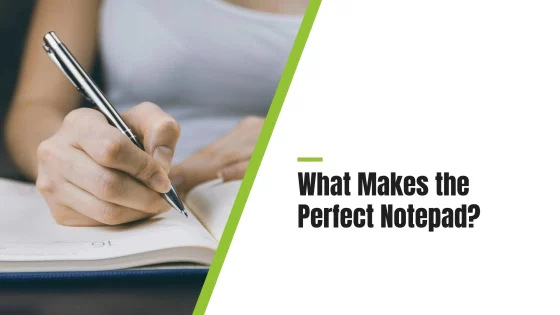The Anatomy of a Perfect Notepad: How to Choose the Best Paper, Binding, and Size
Choosing the right notepad involves understanding paper weight, binding style, and size to match your specific writing or organisational needs. Features like perforated pages, FSC-certified paper, and custom sizing options help improve usability while supporting sustainability and brand consistency.
Not all notepads are created equally. Whether you’re scribbling meeting notes, journalling, sketching, or planning your day, the structure of your notepad can have a big impact on how effective and enjoyable it is to use. This guide breaks down the essential components that define a high-quality notepad, including paper type, binding style, size, and useful features. If you’ve ever wondered why some branded notepads feel better to write on than others, you’ll find everything you need to know right here.
Best Paper for Notepads: Understanding Weight, Finish and Performance
The type of paper used in a notepad plays a key role in the writing experience. It affects how the page feels under your pen or pencil, and whether ink will bleed, smudge or show through.
Paper weight (GSM):
- 70 to 90gsm: Suitable for casual note-taking or use with ballpoint pens. Common in school exercise books.
- 90 to 120gsm: Offers a more premium feel with better resistance to ink bleed. Ideal for journalling or express products like quick turnaround notepads.
- 150 to 160gsm: Heavier paper often found in sketchbooks or A3 custom notebooks. Excellent for fountain pens or markers.
Finish and texture:
- Uncoated paper is more absorbent and better for handwriting.
- Matte or silk-coated paper gives a smoother surface and vibrant colour reproduction, but may not suit every pen.
Opacity:
Higher opacity paper helps prevent ghosting and is especially useful for writing on both sides of the page.
Notepad Binding Options: What to Choose and Why It Matters
Binding affects how a notepad functions day to day. It determines how flat it lies, how easily pages turn, and how durable the pad will be.
Spiral and Wirobound Binding:
- Allows the pad to lie completely flat
- Easy to fold pages back, ideal for sketching and fieldwork
Glued Notepad Binding (PVA or PUR):
- Perfect binding gives a clean, professional appearance
- PUR glue is more durable than standard adhesives
- Suitable for thicker pads of 40 pages or more
Saddle-Stitch Binding:
- A budget-friendly choice for smaller notebooks up to 60 pages
- Uses staples down the middle fold, though it doesn’t always lay flat
Comb Binding:
- Common in office settings
- Pages can be added or removed with ease
Case Binding (Hardcover):
- Offers strength and long-term durability
- A good choice for archiving notes or gifting
Choose your binding based on how you plan to use your notepad and how often it needs to open flat or stay intact over time. For niche applications, consider offering specific notepads tailored to customer needs.
Choosing the Right Notepad Size: A4, A5 and Pocket Options
The size of your notepad should suit your purpose and lifestyle. Whether you need something compact or a spacious writing surface, the right size makes all the difference.
Popular notepad sizes in the UK include:
- A4 (210 x 297 mm): Ideal for detailed notes, diagrams, or office paperwork
- A5 (148 x 210 mm): A portable, everyday option for journalling and general use
- DL (99 x 210 mm): A slim, compact option often used for list-making or desk pads
- A6 “pocket size” (approx. 105 x 148 mm): Great for jotting quick notes on the move
Traditional UK sizes like 178 x 229 mm are still used in some school and office notepads, although A-series sizes have become the standard.

Practical Notepad Features That Make Writing Easier
The best notepads include simple features that improve usability and convenience. Look for:
- Elastic bands to keep pages secure
- Pen holders attached to the cover
- Perforated pages or tear-off corners for neat removal
- Page formats such as lined, dotted, grid, or blank
- Recycled or FSC-certified paper for environmentally conscious buyers
These features add to the usability and comfort of regular notepad use. Learn more.
Examples of Well-Designed Notepads That Work
Some notepads consistently stand out thanks to the way they combine quality materials with thoughtful design. For instance:
- A5 hardback journals using 80gsm acid-free paper, with elastic closures and ribbon markers
- Spiral-bound pads featuring high-opacity 90gsm paper, perfect for fast-paced writing
- Dot-grid bullet journals with 160gsm paper, designed for artistic layouts or daily planning
What makes them effective is that their specifications match the user’s intended purpose. Read more here: Why Aren’t My Printed Notepads Turning Out Right? 7 Common Mistakes

How to Choose the Right Notepad for Your Needs
Before buying your next notepad, consider the following:
- What will it be used for: notes, journalling, sketching, or planning?
- Will you carry it around, or keep it at a desk?
- Do you prefer lined, dotted, grid, or blank pages?
- Is bleed-through resistance important to you?
- Do you need to remove pages easily or archive your notes?
Your answers will guide your decision on paper quality, binding type, and size.
Final Thoughts
A well-made notebook supports how you write, plan and create. By understanding the importance of paper weight, binding options, and sizing, you can find one that fits your needs perfectly. Use this guide to help you select a notepad that suits your work, studies, or creative process.
Ready to find a notepad that ticks all the boxes? Explore your options and choose one that works best for you.
